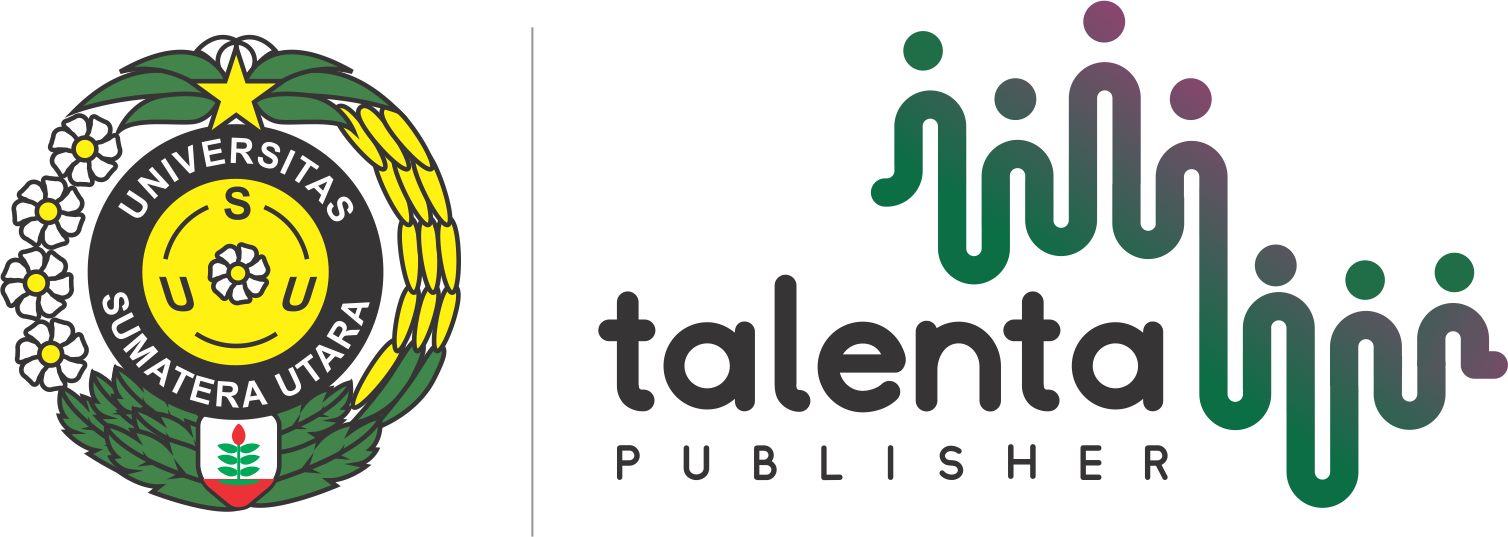Pengaruh Efektivitas Kayu Manis (Cinnamomum burmannii) dan Bunga Cengkeh (Syzygium aromaticum) sebagai Antiseptik terhadap Pertumbuhan Bakteri Escherichia coli
DOI:
https://doi.org/10.32734/trophico.v4i2.17598Keywords:
Cinnamon, clove, Escherichia coli, antisepticAbstract
Unclean hands can transfer Escherichia coli from the body, feces, or other sources to food which when consumed can cause diarrhea. One solution to maintain hand hygiene is the use of natural antiseptic. This study aims to determine the effectiveness of cinnamon and cloves as antiseptics against the growth of Escherichia coli. This study is a quantitative study with a true experimental method with a post-test only control design. Testing the inhibition of Escherichia coli in antiseptic extracts using the Kirby-Bauer test with 3 repetitions. The extracts used were obtained from the maceration process and made into several concentrations, namely 20%, 40%, 60%, 80%, and 100%. The positive controls used were Chloramphenicol Palmitate antibiotics and 70% alcohol antiseptic. The negative control in this study was aquadest. The measurement results after 24 hours showed that concentrations of 20%, 40%, 60%, 80%, and 100% respectively effectively inhibited the growth of Escherichia coli because there were clear zones of 10,067 mm, 10,867 mm, 11,267 mm, 12,833 mm, and 13,4 mm. Data analysis using the Kruskal-wallis test showed p- value was 0,026. This means there is a significant difference in the average diameter of the inhibition zone. Through the Post Hoc Multiple Comparison test, it was found that 20% until 80% concentrations had no significant difference with 70% alcohol antiseptic, p-value > 0,05, but 100% concentration had a significant difference with 70% alcohol antiseptic because it had a p-value= 0,036. Starting from 20% concentration, can replace 70% alcohol antiseptic.
Downloads
References
Ardani, M., Pratiwi, S. U. T., & Hertiani, T. (2010). Efek campuran minyak atsiri daun cengkeh dan kulit batang kayu manis sebagai antiplak gigi. Majalah Farmasi Indonesia, 21(3), 191–201.
Ariani, A. P. (2017). Diare pencegahan dan pengobatannya (Edisi ke-1). Nuha Medika.
Hidayah, N., Hisan, A. K., Solikin, A., Irawati, & Mustikaningtyas, D. (2016). Uji efektivitas ekstrak Sargassum muticum sebagai alternatif obat bisul akibat aktivitas Staphylococcus aureus. Journal of Creativity Student, 1(2). https://doi.org/10.15294/jcs.v1i2.7794
Intaningtyas, E. D., Fatimah, & Safitri, Y. D. (2023). Perbandingan aktivitas antibakteri rebusan batang, bunga, dan daun cengkeh (Syzygium aromaticum) terhadap pertumbuhan bakteri Escherichia coli ATCC 25922. Jurnal Farmasi Higea, 15(1), 71–76.
Khasanah, L. U., Utami, R., Manuhara, G. J., Fattahillah, Q., & Setyowati1, F. P. (2018). Pengaruh Perlakuan Pendiaman dan Konsentrasi Etanol terhadap Oleoresin Daun dan Kulit Batang Kayu Manis (Cinnamomum burmanii). Prosiding Seminar Nasional, 8, 101–116. http://eprints.ubhara.ac.id/821/1/CoverProsidingSemnas_KontrolKorupsi2018Penelitian.pdf#page=119
Mursyida, E., & Wati, H. M. (2021). Aktivitas Antibakteri Ekstrak Kayu Manis (Cinnamomum Burmannii) terhadap Pertumbuhan Escherichia Coli. Jurnal Kedokteran Dan Kesehatan: Publikasi Ilmiah Fakultas Kedokteran Universitas Sriwijaya, 8(2), 87–92. https://doi.org/10.32539/v8i2.11952
Ouchari, L., Boukeskasse, A., Bouizgarne, B., & Ouhdouch, Y. (2019). Antimicrobial potential of actinomycetes isolated from the unexplored hot Merzouga desert and their taxonomic diversity. Biology Open, 8(2), 1–7. https://doi.org/10.1242/bio.035410
Parhusip, A. J. N., & Cynthia, L. J. (2019). Aplikasi Ekstrak Kulit Kayu Manis (Cinnamomum burmanii) untuk Menghambat Aktivitas Bakteri Ikan Lele (Clarias batrachus). Jurnal Sains Dan Teknologi, 3(2), 66–84.
Parisa, N., Islami, R. N., Amalia, E., Mariana, & Rasyid, R. S. P. (2019). Anntibacterial Activity of Cinnamon Estract (Cinnamomum burmanii) against Staphylococcus aureus and Escherichia coli In Vitro. Bioscientia Medicina, 3(2), 19–28. https://www.bioscmed.com/index.php/bsm/article/view/85/82
Penta Chemicals Unlimited. (2024). Safety Data Sheet Ethanol 96%. https://us.vwr.com/assetsvc/asset/en_US/id/16490607/contents
Ratmaja, I. G. A. N. D., Darwinata, A. E., Pinatih, K. J. P., & Fatmawati, N. N. D. (2023). Perbandingan efektivitas mencuci tangan dengan air, sabun antiseptik, hand sanitizer gel, dan alkohol 70% terhadap jumlah bakteri pada tangan. Jurnal Medika Udayana, 12(8), 56–61.
Reddish, G. F. (1961). Antiseptics, Disinfectans, Fungicides, and Chemical and Physical Sterilization (2nd ed.). St. Louis College of Pharmacy and Allied Sciences, and Lambert-Hudnut Division of Warner- Lambert Pharmaceutical Company.
Riskesdas Kementrian Kesehatan RI. (2018). Laporan Riskesdas 2018 Nasional. In Lembaga Penerbit Badan Penelitian dan Pengembangan Kesehatan (LPB). https://repository.badankebijakan.kemkes.go.id/ id/eprint/3514/
Willian, N., & Pardi, H. (2022). Buku ajar pemisahan kimia: Sebuah pengantar pada aspek kemaritiman. In
UMRAH Press (Ke-1). http://www.nber.org/papers/w16019
Zulfikri, A., & Ashar, Y. K. (2020). Dampak Cairan Disinfektan terhadap Kulit Tim Penyemprot Gugus Tugas Covid-19 Kota Binjai. Jurnal Menara Medika, 3(1), 7–14. https://www.google.com/urlsa=t&source=web&rct=j&url=https://jurnal.umsb.ac.id/index.php/menaramedika/article/view/2199&ved=2ahUKEwja66i_paDtAhU263MBHdUiAsUQFjAAegQIAxAB &usg=AOvVaw0bUdEhasRIBe0InxidlHJo
Downloads
Published
How to Cite
Issue
Section
License
Copyright (c) 2024 Tropical Public Health Journal

This work is licensed under a Creative Commons Attribution-ShareAlike 4.0 International License.
















